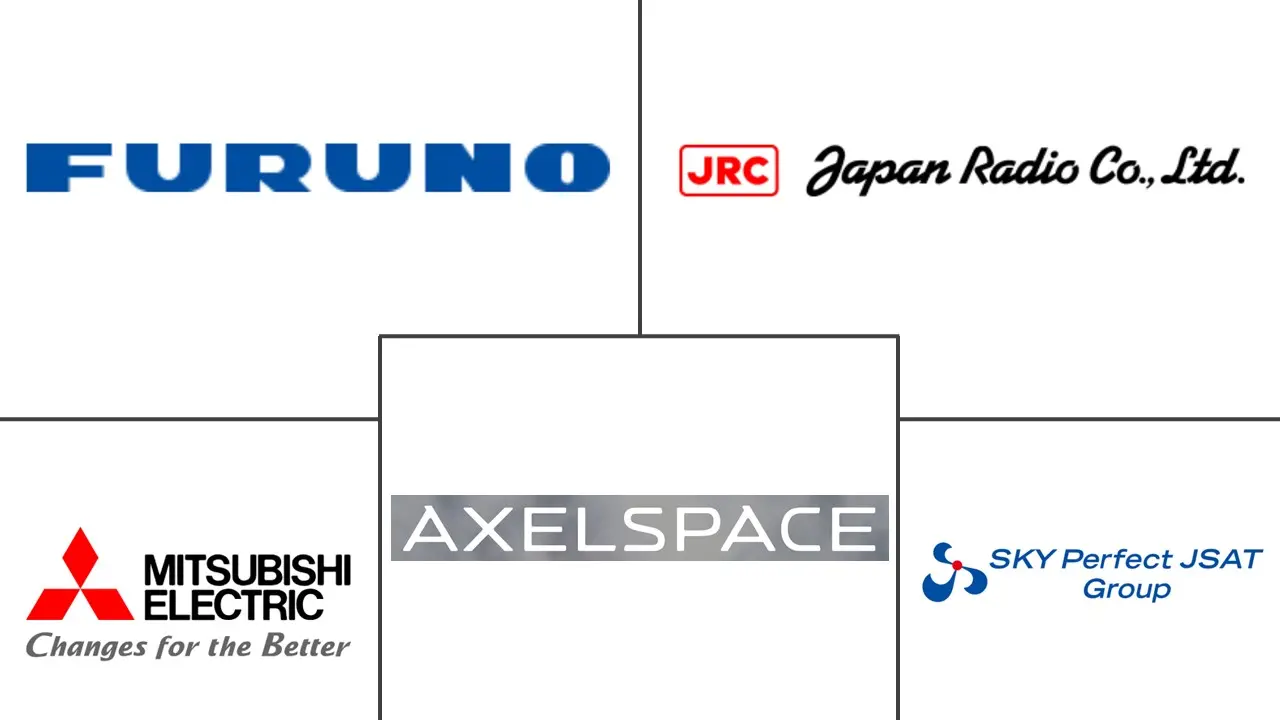Japan Satellite Communication Market Size and Share
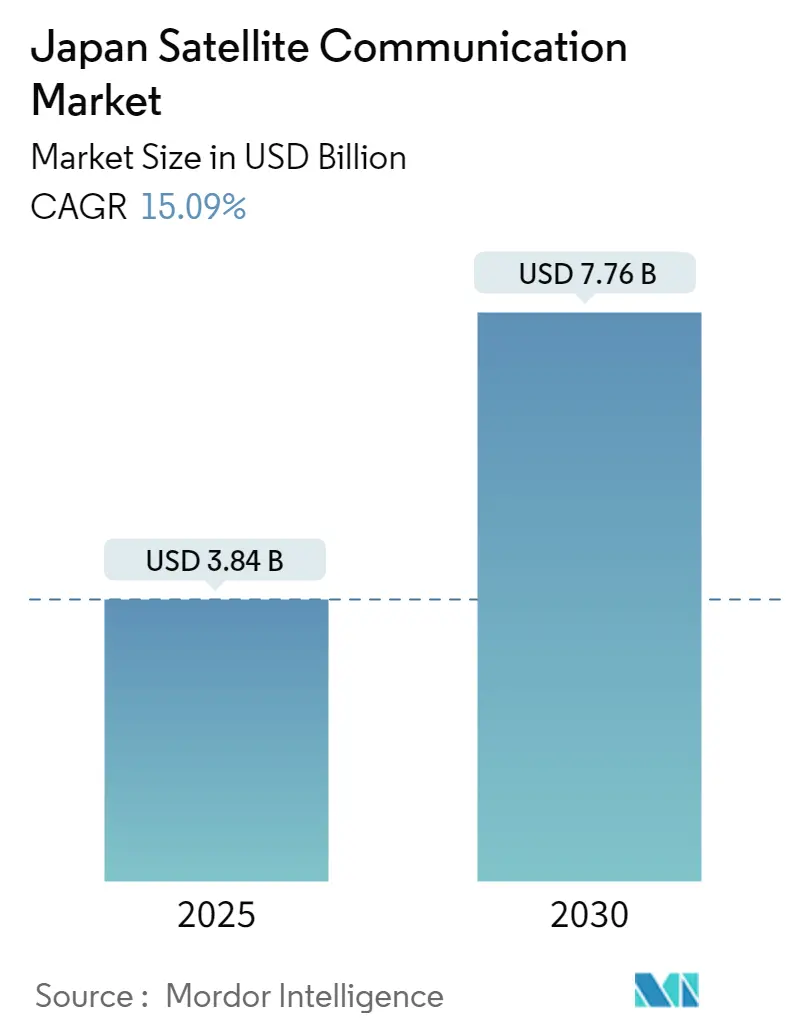
Japan Satellite Communication Market Analysis by Mordor Intelligence
The Japan Satellite Communication Market size is estimated at USD 3.84 billion in 2025, and is expected to reach USD 7.76 billion by 2030, at a CAGR of 15.09% during the forecast period (2025-2030).
One of the main factors driving the satellite communication industry is Japan's growing requirement for high-speed and consistent broadband connectivity.
- The introduction of 5G technology and technological advancements are one of the primary drivers of the market in Japan. The satellites improve coverage in outlying areas and supplement terrestrial networks. Key competitors are investing in the market through mergers, acquisitions, and other means to grow their presence among customers and better serve their needs across a range of applications.
- For instance, in May 2023, to build local 5G networks employing Dynamic Spectrum Access (DSA) technology on urban expressways in Japan, Sony and Mitsui collaborated on a system feasibility testing study. The businesses claim that this project represents the first effort ever made to use Dynamic Spectrum Access (DSA) technology for local 5G networks to provide automatic coordination of wireless spectrum and prevent damaging radio interference issues. As a result, this project is predicted to significantly contribute to encouraging cooperative usage of local 5G networks in Japan.
- The Japanese government has been actively promoting the satellite communications sector through initiatives and investments. Collaborations and public-private partnerships are also promoting innovation in the industry. Together, these developments help the satellite communication market in Japan expand and advance, enabling better connection, data services, and technical advancements across a range of businesses and sectors. In addition, satellite-based communication systems are used in mobile, automotive, and other applications that require connectivity while in motion. Expanding IoT hardware and software necessitates stable connectivity with a broad reach.
- However, factors like interference in data transmission might be a significant concern that can hamper the overall market's growth throughout the forecast period. Since launching a satellite to send data is a highly sensitive process, cybersecurity has become a significant issue for satellite communication, which can hinder the market's growth.
- Factors like the rising demand for mobile broadband, the growing use of smartphones and smart wearable devices, and the surging demand for mobile video adoption are expected to drive the growth of 5G over the forecast period, which is expected to aid the growth of the market studied. According to the Ministry of Internal Affairs and Communications (Japan), the number of fixed-line broadband service subscriptions in Japan amounted to 44.7 million in 2023, up 0.7 million from the previous year.
Japan Satellite Communication Market Trends and Insights
The Media and Entertainment Segment is Expected to Hold a Considerable Market Share
- There is a significant international audience for the content produced by Japan's media and entertainment sector. The distribution of Japanese media content internationally depends heavily on satellite transmission. Satellites allow TV shows, films, anime, and other media content to be sent to many parts of the world, enabling global audiences and promoting the export of Japanese entertainment.
- Japan's media and entertainment sector depends on satellite communication for broadcasting, distribution, delivering worldwide content, providing emergency services, and creating material. The industry's use of satellite communication has improved its operations and helped the Japanese satellite communication market expand and prosper.
- Satellite communication is frequently used for broadcasting radio and television transmissions. The distribution of radio and television shows to a large audience relies primarily on satellite communication in Japan's media and entertainment sector. Satellites are used by broadcasting firms to transmit their signals across the nation, assuring coverage in outlying regions and enabling universal access to media content.
- Additionally, satellite communication has aided Japan's media and entertainment sector's expansion of DTH services. DTH operators use satellites to send television signals straight to subscribers' homes. The reach of media material can now be extended to remote or underserved locations. This technology enables viewers to access various channels and services without requiring terrestrial infrastructure.
- As per the Ministry of Internal Affairs and Communications (Japan), in 2023, there were around 38.07 million fiber-to-the-home (FTTH) subscriptions in Japan, making FTTH the most widely utilized form of fixed-line broadband. Cable television (CATV) and digital subscriber line (DSL) connections came after that. Over 44.71 million fixed-line broadband subscriptions were made in total during that year.
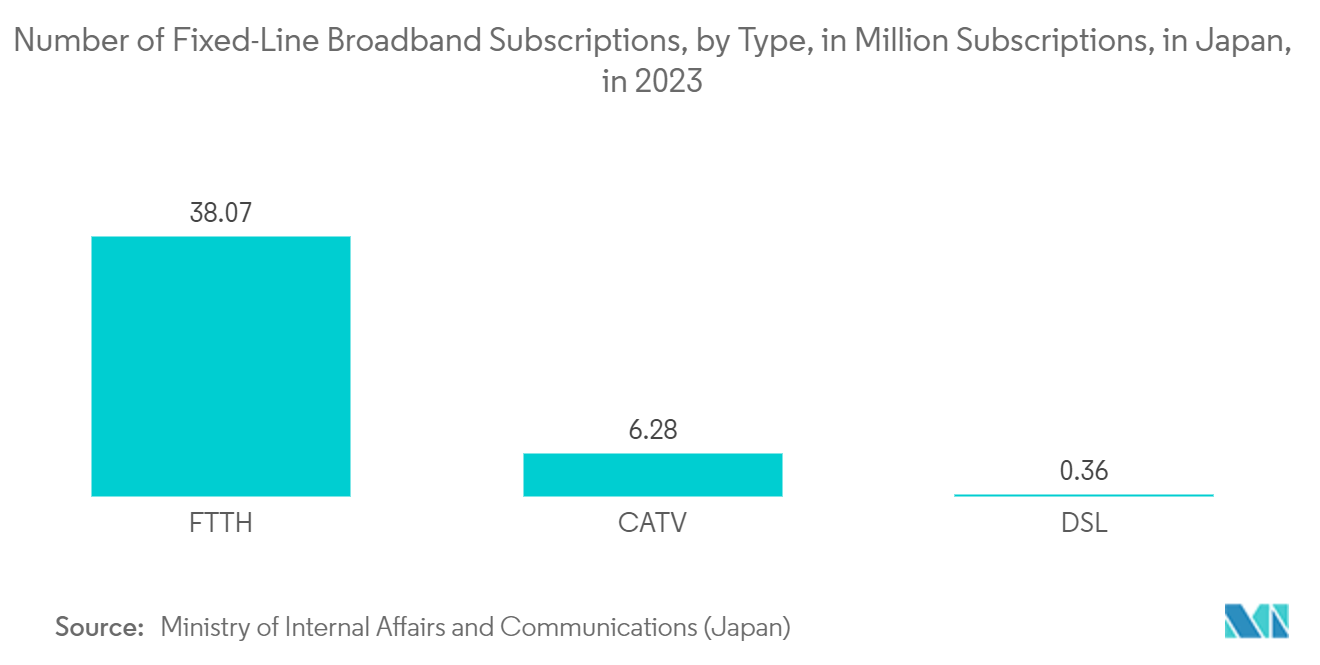
Increase in IoT and Autonomous Systems is Driving the Market
- Japan has been actively utilizing its IoT systems to enhance the satellite communication sector. Japan has a long history of developing satellite technology and space exploration, and the incorporation of IoT has increased its capabilities in this area.
- The market is expanding due to the increased focus on digital technology, AI, robots, cyber security, and healthcare IT. The development of the ICT market in Japan is primarily driven by the growing adoption of IoT-based devices across numerous industries, including consumer electronics, the military, agriculture, and construction. The presence of prominent ICT companies in Japan, such as Sony, Panasonic, Fujitsu, NEC, and Toshiba, contributes significantly to the country's growth as a major ICT hub. The proper development of various modernization and improvement projects around the nation and the rising government spending on sustaining superior and innovative infrastructures are also fueling the market's expansion.
- Major competitors are investing in the market through mergers, acquisitions, and other means to expand their client base and better meet their demands across various applications. For instance, in December 2022, KDDI announced that the first mobile tower in Japan to use Starlink had started commercial operation in Hatsushima, a remote island in Sagami Bay. Starting with this location, KDDI would expand its coverage to 1,200 remote towers to pursue its vision of bringing an urban mobile experience to its rural customers.
- In March 2023, Nippon Telegraph and Telephone Corporation and KDDI Corporation signed an MoU to promote global standardization in the field of optical networks, such as optical transmission technology, mobile network technology, and operations management technology, where both companies can leverage their technological strengths. Both companies would accelerate open innovations with partners worldwide, aiming to contribute to global standardization.
- As per the Ministry of Internal Affairs and Communications (Japan), in FY 2021, the private investment in the Japanese information technology (IT) market was estimated at JPY 13.55 trillion. In part because of increasing investments in the telework infrastructure during the COVID-pandemic, it surged by around JPY 580 billion from the previous year. By FY 2024, it was anticipated that the investment volume would increase even more and reach JPY 14.6 trillion.
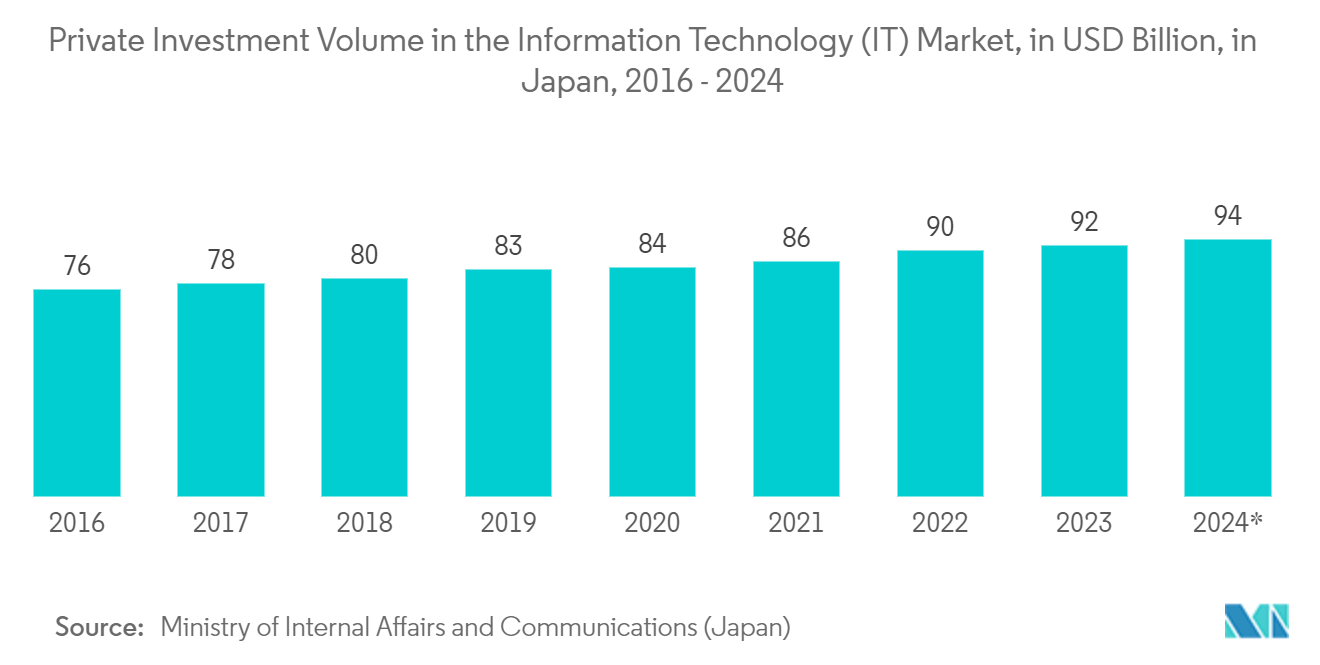
Competitive Landscape
- May 2023 - The USSF declared the delivery of the second of two Space Domain Awareness sensors to Japan that would be hosted on Japanese satellites to build SDA capacity and resiliency in support of a US-Japan cooperative effort called Quasi-Zenith Satellite System Hosted Payload.
- January 2023 - Japan successfully launched a rocket carrying a government intelligence satellite on a mission to monitor activity at military facilities in North Korea and enhance the country's response to disasters. As part of Tokyo's efforts to strengthen its military capacity in response to escalating threats, the H2A rocket, launched by Mitsubishi Heavy Industries, safely lifted off from the Tanegashima Space Centre in southwestern Japan with the IGS-Radar 7 surveillance satellite aboard.
Japan Satellite Communication Industry Leaders
-
Mitsubishi Electric
-
Axelspace Corporation
-
Furuno Electric Co., Ltd.
-
New Japan Radio Co., Ltd.
-
SKY Perfect JSAT Corporation
- *Disclaimer: Major Players sorted in no particular order
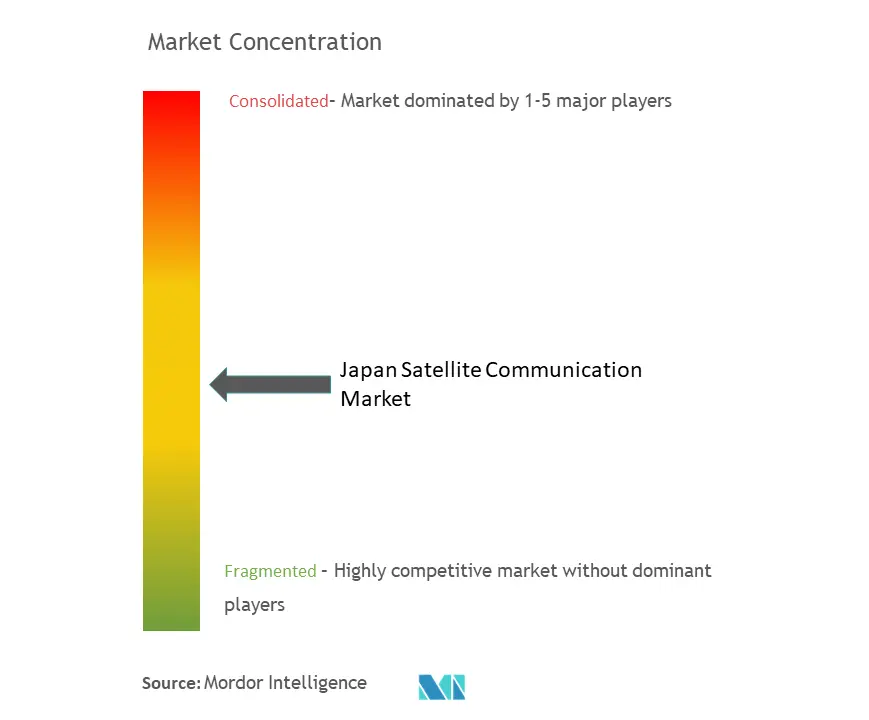
Recent Industry Developments
- March 2023 - The Japan Aerospace Exploration Agency, or JAXA, chose SKY Perfect JSAT as a service provider for the Near-Earth Tracking and Control Network. They want to create new ground stations worldwide by cooperating with SKY Perfect JSAT and KSAT to offer Near-Earth Tracking and Control Services to JAXA and other Japanese state organizations.
- November 2022 - Japan Space Imaging Corporation (JSI), a Japanese space firm, and Satellite Vu entered a new agreement under which JSI will employ Satellite Vu's pictures, products, and services to enhance its worldwide imaging portfolio with high-resolution thermal data. The deal comes after Satellite Vu's early access option program (EAOP) launched.
Japan Satellite Communication Market Report Scope
Satellite communication is the transfer of data and information via satellites orbiting the Earth. It enables long-distance communication by relaying signals between ground stations and satellite receivers in orbit, enabling television broadcasts, internet access, and phone calls. The satellite communication (SATCOM) market is defined based on the revenues generated from the types used in various end-user verticals such as maritime, defense and government, enterprises, and media and entertainment. The analysis is based on the market insights captured through secondary research and the primaries. The report also covers the major factors impacting the market's growth in terms of drivers and restraints.
The scope of the study has been segmented based on the type of satellite communication equipment and services (ground equipment (a gateway, very small aperture terminal (VSAT) equipment, network operation center (NOC), and satellite newsgathering (SNG) equipment) and services (mobile satellite services (MSS), fixed satellite services, and earth observation services), platform (portable, land, maritime, and airborne), and end-user vertical (maritime, defense and government, enterprises, media and entertainment, and other end-user verticals). Common satellite communication services include voice calling and internet access for different applications. The report offers market forecasts and size in value (USD) for all the above segments.
The study tracks the key market parameters, underlying growth influencers, and major vendors operating in the industry, supporting the market estimations and growth rates over the forecast period. In addition, the study provides the SATCOM market trends, along with key vendor profiles. The study further analyzes the overall impact of COVID-19 on the ecosystem.
| Ground Equipment |
| Services |
| Portable |
| Land |
| Maritime |
| Airborne |
| Maritime |
| Defense and Government |
| Enterprises |
| Media and Entertainment |
| Other End-user Verticals |
| By Type | Ground Equipment |
| Services | |
| By Platform | Portable |
| Land | |
| Maritime | |
| Airborne | |
| By End-user Vertical | Maritime |
| Defense and Government | |
| Enterprises | |
| Media and Entertainment | |
| Other End-user Verticals |
Key Questions Answered in the Report
How big is the Japan Satellite Communication Market?
The Japan Satellite Communication Market size is expected to reach USD 3.84 billion in 2025 and grow at a CAGR of 15.09% to reach USD 7.76 billion by 2030.
What is the current Japan Satellite Communication Market size?
In 2025, the Japan Satellite Communication Market size is expected to reach USD 3.84 billion.
Who are the key players in Japan Satellite Communication Market?
Mitsubishi Electric, Axelspace Corporation, Furuno Electric Co., Ltd., New Japan Radio Co., Ltd. and SKY Perfect JSAT Corporation are the major companies operating in the Japan Satellite Communication Market.
What years does this Japan Satellite Communication Market cover, and what was the market size in 2024?
In 2024, the Japan Satellite Communication Market size was estimated at USD 3.26 billion. The report covers the Japan Satellite Communication Market historical market size for years: 2019, 2020, 2021, 2022, 2023 and 2024. The report also forecasts the Japan Satellite Communication Market size for years: 2025, 2026, 2027, 2028, 2029 and 2030.
Page last updated on:
Japan Satellite Communication Market Report
Statistics for the 2025 Japan Satellite Communication market share, size and revenue growth rate, created by Mordor Intelligence™ Industry Reports. Japan Satellite Communication analysis includes a market forecast outlook for 2025 to 2030 and historical overview. Get a sample of this industry analysis as a free report PDF download.
